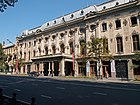Aleksander Szymkiewicz
Aleksander Szymkiewicz | |
|---|---|
 | |
| Born | November 12, 1858 |
| Died | 1908 |
| Nationality | Polish |
| Occupation | Architect |
| Buildings | Supreme Court of Georgia, Tbilisi State Conservatoire, Rustaveli Theatre |
Aleksander Szymkiewicz (12 November 1858, in Saint Petersburg – 1908, in Tbilisi) was a Polish architect who worked in Georgia (primarily in Tbilisi) in the 1880s–1900s. He was a member of the City Council and municipal architect of Tbilisi from 1885 to 1891.[1][2]
In Tbilisi, he designed, among others, the building of the Supreme Court of Georgia, the Conservatoire building, the building of the Caucasian Silk Station (now the State Silk Museum), the building of the Rustaveli Theatre (with Cornell K. Tatishchev), and various townhouses, including the Andreoletti's house.[2][3][4][5] He also designed the building of the Shota Rustaveli State University in Batumi and the Court of Appeals in Kutaisi.[5] His designs combined baroque and classical elements.[2]

Gallery
-
Supreme Court of Georgia in Tbilisi
-
Court of Appeals in Kutaisi
-
Rustaveli Theatre in Tbilisi
References
- ^ Wystawa pt. "Polacy w Gruzji" Archived 2013-04-16 at archive.today. Poles in Georgia[permanent dead link]. Retrieved 2013-02-28.
- ^ a b c Doijašvili, Manana (2008). The Vano Saradjishvili Tbilisi State Conservatoire, 1917-2007. Nova Science Publishers. p. 87.
- ^ State Silk Museum. Retrieved 2013-02-28.
- ^ Wojtasiewicz, Wojciech (2012). "Wkład Polaków w rozwój Gruzji w drugiej połowie XIX i na początku XX wieku". In Stawowy-Kawka, Irena (ed.). Międzycywilizacyjny dialog w świecie słowiańskim w XX i XXI wieku (in Polish). Kraków: Księgarnia Akademicka. p. 65. ISBN 978-83-7638-199-2.
- ^ a b Opaska, Janusz (2012). "Działalność polskich architektów w Tbilisi w XIX i początkach XX wieku". Kwartalnik Architektury i Urbanistyki (in Polish). No. 57/1. p. 12.




